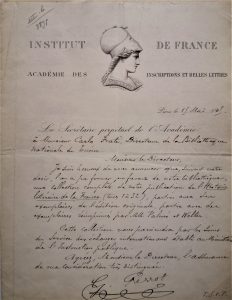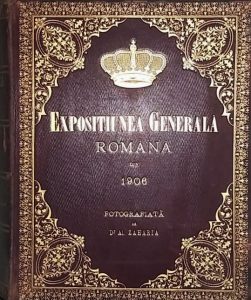 The contribution of private donations to the volumes found in the perforated boxes is significant, with over 70 donors, including families, individuals, and publishers, contributing approximately 360 works in total. Notable donors include Professor and librarian of Cambridge, John Eyton Bickersteth Mayor (1825-1910), who donated 200 volumes, and historian Alberto Emanuele Lumbroso (1872-1942), who contributed 89 volumes. Publishing houses such as Loescher, Lattes, Paravia, Sansoni, and the historic Turin-based Fratelli Bocca also made substantial donations. Other noteworthy contributors include the Italian Bibliographic Society, Professor Camus, Domenico Perrero, Emilio Pinchia, the heirs of economist Salvatore Cognetti De Martiis, and the “Fiore sisters,” who donated 47 ancient volumes from their family collection.
The contribution of private donations to the volumes found in the perforated boxes is significant, with over 70 donors, including families, individuals, and publishers, contributing approximately 360 works in total. Notable donors include Professor and librarian of Cambridge, John Eyton Bickersteth Mayor (1825-1910), who donated 200 volumes, and historian Alberto Emanuele Lumbroso (1872-1942), who contributed 89 volumes. Publishing houses such as Loescher, Lattes, Paravia, Sansoni, and the historic Turin-based Fratelli Bocca also made substantial donations. Other noteworthy contributors include the Italian Bibliographic Society, Professor Camus, Domenico Perrero, Emilio Pinchia, the heirs of economist Salvatore Cognetti De Martiis, and the “Fiore sisters,” who donated 47 ancient volumes from their family collection.
Donations from abroad
After the 1904 fire, the Library received a significant portion of donations from abroad, demonstrating global solidarity with the Turin Institute. These donations include over 400 volumes from more than thirty donors worldwide, including university libraries from various cities such as Strasbourg, Utrecht, Königsberg (now Kaliningrad, Russia), Liège,

Copenhagen, Leipzig, Berlin, Kiel, Cambridge, Prague, Bratislava, Harvard, Princeton, and Toronto. Cultural institutes and associations, such as the National Library of Spain in Madrid, the Hamburg Library, and the British Museum in London, also contributed. Additionally, government bodies from countries like the Philippines, Romania, and Suriname, as well as departments of culture from Weimar and the Municipal Council of Gotha, provided support through donations to the Library. The donations to the National Library came from various continents, including Africa, America, Australia, and Europe.
These contributions typically consisted of small sets of 4-5 volumes per institution, primarily focusing on the local history and traditions of the donating countries, often in their original languages. The international nature of these donations is particularly striking, considering the limited communication and transportation capabilities compared to modern times.

One noteworthy donation is from the Romanian government, comprising a collection of 243 early 20th-century photographs. These photographs depict temporary constructions and representations created for the International Exhibition held in Bucharest in 1906. The collection, contained in luxurious book-shaped cases made of wood and covered in red leather with intricate gold impressions, provides a unique and unpublished visual record, tailored for an Italian audience.
At the national level, several ministries, including Public Education, Agriculture, and Industry, contributed approximately 3,500 volumes to the National Library’s collection. Additionally, the Library of the Chamber of Deputies donated another 200 works. These donations primarily consisted of modern volumes such as bulletins, periodicals, dictionaries, and encyclopedias, some of which had previously been donated to the Ministries. Noteworthy items include typewritten or handwritten volumes containing articles and studies awarded on various occasions.
Furthermore, approximately 500 volumes were donated by various Italian institutes and organizations, representing a diverse range of entities. These donors included institutions such as the San Carlo Technical Schools, the Polytechnic University of Turin, the Royal Italian Industrial Museum, the Military Academy, the Royal Prosecutor’s Office of Turin, the Legal Institute of the Royal University of Turin, the Carlo Alberto College, the Chamber of Commerce and Industry of Trieste, the Academy of Udine, and the Royal Institute of Higher Studies of Florence.
The donated publications mainly focused on topics relevant to the respective entities, comprising brochures or monographs published in the years leading up to the fire.

Approximately 1,300 texts were donated by various Italian libraries to the National Library. These donations included contributions from institutions such as the National Library of Milan, which provided 31 volumes (including 13 ancient ones); the University Library of Cagliari – Government Library, which sent 163 volumes (156 of which were ancient), focusing on theatrical and literary works; the Archiginnasio in Bologna, which donated nearly a thousand ancient volumes; the Brera Library in Milan, which contributed 31 volumes (including 18 modern ones on historical and political-philosophical subjects); the Public Library of Siena, which donated 17 modern volumes on economic-scientific subjects and local history; the Government Library of Lucca, which provided 135 volumes (including 103 ancient ones of literary nature); the Alessandrina Library in Rome, offering 14 volumes; the Casanatense Library in Rome, contributing 19 ancient volumes on the papacy of Leo X and history; the National Library of Palermo, donating over 50 ancient titles of historical-literary nature; the Municipal Library of Cesena, contributing 19 volumes on various subjects dating back to the 19th century; the University Library of Pisa, which provided 3 books; and finally, the Leardi Library in Casale Monferrato, offering 2 books. Each volume from these Italian institutes bore the stamps of the donating library, often marked as “duplicate,” indicating that they were additional copies of specimens already owned by the donating libraries.

